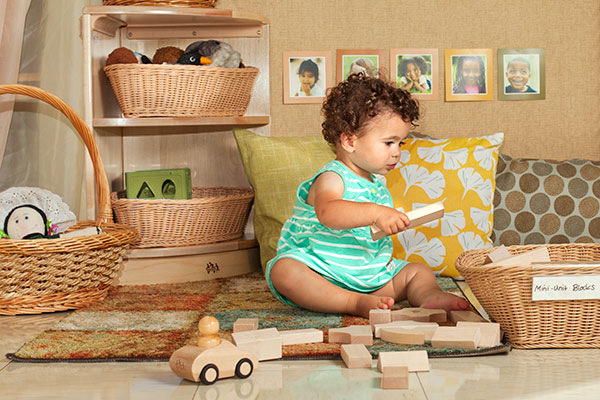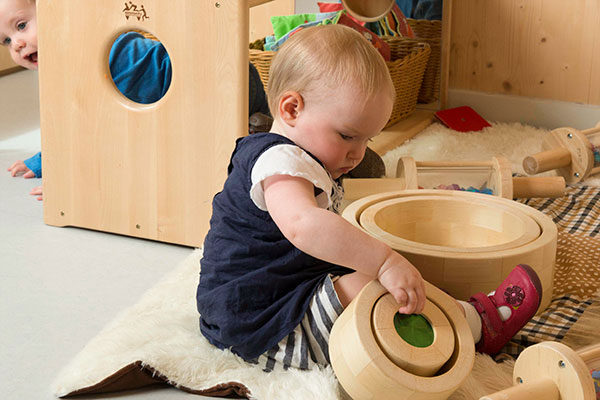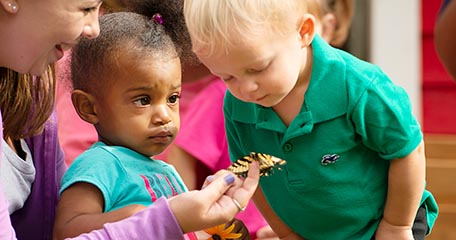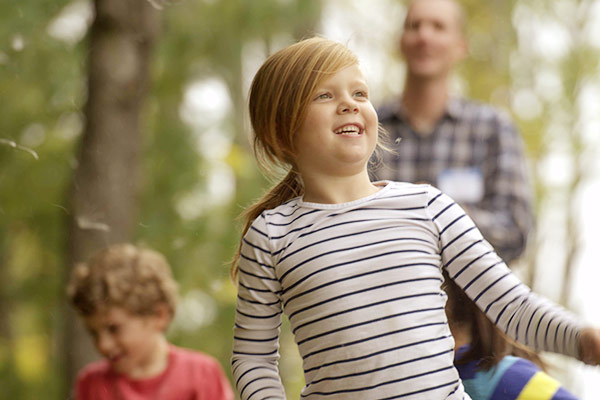Enjoyable play from the first months
| May 2020Babies and very young children love to play, and some bought play resources can be very useful. However, many suitable play items are safe, ordinary items and not commercially produced toys. In a nutshell, babies, toddlers and very young children need first-hand experiences; they need to be able to relate directly to useful play resources which are geared appropriately to their current skills and level of understanding.
Hear and make sounds
- If all is going well, very young babies are attracted to the rhythm of the human voice and their brains are designed to tune into language.
- Babies and then toddlers become adept at deliberate sound making. So they need you, a real person, or enthusiastic older children, to treat their trills of sound and first goes at words as exciting, real chat.
- These efforts at two-way communication are often provoked by shared time with toddlers’ favourite picture or story books. Be prepared to read, tell and share favourites many times.
To-and-fro chat is also supported by the fun of finding a small toy hidden under a cover or dropping a toy that an adult or older sibling is happy to retrieve--again and again. - Toddlers and very young children like to make deliberate sounds. Some of their sound making will be with their own voice, through tuneful chatting, echoing the words of a favourite story and joining in a familiar song or nursery rhyme.
- Very young children also like simple sound makers: shakers, rattlers and tapping sticks. You can buy some very simple sound and music makers.
- Simple music boxes are best and babies are not helped by having sounds bursting out of all their toys.
- But you can also create good sound makers from small plastic bottles, filled with different substances and with the lid screwed back tightly.
The entire toy industry cannot produce anything that substitutes for a kind, playful, emotionally involved adult. Unfortunately, there is a successful market in battery-driven plastic toys, even electronic pads for use with babies, that claim to support early communication skills. Sadly, some parents, or unreflective early years practitioners, are tempted to delegate the role of communicator to the disembodied voice of a total stranger.
No electronic toy ever blew a raspberry back to a happy toddler who started the sound making exchange. Toddlers’ first words arise from the personal details of their daily life. Batteries can power the ready-packaged sounds of a ‘First Words’ bright plastic console. But a battery will never know that this toddler wants to say ‘duck’ rather than ‘dog’, nor that Daddy rides a ‘mo-bike’.
Touch and feel
- Very young babies want to see the world from your arms. But once they can sit securely, older babies are in the business of working out what does what. They need items that they can explore with their eyes, grasp with their hands and put safely to their mouths.
- Very young children need a range of materials so they can explore texture. They love a treasure trove of different scraps of cloth. They relish getting their hands into different natural materials: sand, water or shredded paper. So you need a range of suitable containers or baskets.
- Toddlers need simple items and containers, for putting things in and out, many times. They want to explore with hands and eyes what will fit through a slot and what will not. So simple posting boxes are best, ideally in quiet colours or in wood.
- Toddlers do not need canned music to provoke them into repeating their actions. They like to hear a satisfying thunk as a shape (ideally wooden) hits the inside of the posting or the ding of a bell they have worked out how to operate themselves.
- Children learn the first-hand understanding of feel and fit long before they will make any sense of the abstract words for shapes. A real, involved adult can be encouraging and say appropriate words. But children do not benefit from strangers speaking from the depths of a posting box or a moulded plastic ‘early learning table’.
Look and explore
- Young babies have yet to find their own hands and feet – and very interesting they are too as fingers come in and out of the visual field. Babies put immense effort into getting their eyes and hands to work in unison.
- Young babies will stretch out to touch a soft toy that they could not yet hold alone. But soon a hand will join yours at the side of an interesting picture board book. It will not be long before a baby will scrabble at the shiny picture.
- A simple bought rattle will get the attention of a baby, who soon closes a firm grip around the handle and begins to research what action causes the rattle to make a sound. But babies will be equally interested to explore a smooth wooden spoon. They can stare, stretch out, feel and try to grasp.
- Babies can directly compare the sound making power of the rattle or a bell inside a cloth cube. On the other hand, a wooden spoon makes no sound however hard you shake it. But if you bash it on your highchair tray or drop it over the side, then you have noise!
- Older babies and toddlers like to look at themselves and appreciate a mirror they can hold in their hands, as well as one fixed low down against the wall.
Using all the senses
- As soon as babies become more co-ordinated, they happily use all their senses, sometimes at the same time.
- A steady stare at a favourite soft toy can be accompanied with stroking and cuddling. Toddlers soon rework their own care through imaginative play with Monkey. Simple useful props are best so that toddlers and twos can tuck Monkey into bed, take him for a stroll in the trolley or organise a tea party.
- A generous supply of basic bricks or blocks, ideally wooden, will come into their own from toddlers’ first attempts at towers – when knocking down is just as exciting as building up. But the store will continue in full use to support four-year-old construction of dinosaur enclosures and castles.
- Suitable small world figures are valuable play resources as older toddlers and twos develop more sophisticated pretend play. Young children still suck some items, so play people and animals, like any other resources, need to be safe to go in the mouth.
- Crawling babies, toddlers and twos need to use their whole body as they practise large co-ordinations, left-right balance of crawling and the planning needed to climb up, over, through and around.
- A tolerant adult body is ideal for clambering over and an excellent gym support for bouncing. However, cushions, crawl tunnels and basic clambering equipment offer further exciting possibilities.
- Once young toddlers are steady on their feet, a stable wheeled vehicle like a trolley will support play as a pushalong, a transporter of Monkey or large supplies of bricks.
Parents and early years practitioners need to consider what genuinely supports early learning and the excitement of play. Some bought toys or equipment will be good value because the materials really do suit the grasping power of little hands or fit the simple pretend play of older toddlers and young twos. However, some toys do not support early learning, no matter what it says on the packaging or claims on the company website. Certainly, young children who are still working out spoken language do not benefit in any way from having letters and numbers made an integral part of toys.








